Changing Food Consumption Patterns and Land Requirements for Food in the Six Geopolitical Zones in Nigeria
Abstract
:1. Introduction
2. Material and Methods
2.1. Brief Introduction of the Study Area
2.2. Data Source
2.3. Calculation of Household Food Consumption and Associated Land Requirement
- (i)
- Measuring household food quantity consumption.
- (ii)
- Estimating land requirements for food.
- (a)
- The food consumption quantity (kg/capita/year) of rice, maize, cassava, yam, onions, and tomatoes was calculated from the FAOSTAT food balance sheet from 2000 to 2018.
- (b)
- The specific land requirements (m2 year kg−1) for each food considered in our research were calculated by dividing consumption (kg) in (a) by yield (kg/ha) collated from FAOSTAT from 2000 to 2018.
- (c)
- The per capita land requirements (m2) for food were also calculated by combining the food consumption results in (a) and the specific land requirements of the food crops in (b) (see Figure 2).
- (a)
- The LRF at the household level was calculated using the household food consumption quantity (kg/household/year) of rice, maize, cassava, yam, cowpea, onions, and tomatoes from Equation (2) above.
- (b)
- To estimate the yield (kg/ha) as it is needed to calculate the LRF in the six geopolitical zones, the 36 states were grouped into their respective geopolitical zones and their average crop production and harvested area of rice, maize, cassava, yam, cowpea, onions, and tomatoes were calculated.
- (c)
- To calculate the specific land requirements for food (ha/year), the 36 states were grouped into their respective geopolitical zones and each food item consumption quantity in (a) which was derived from Equation (2) (kg/household/year) was divided by their specific yield (ha) results obtained in (b).
- (d)
- The per capita land requirements (ha) for food in the six geopolitical zones were calculated by multiplying the specific LRF (ha/year) in (c) by the food consumption quantity from Equation (2) (kg/household/year).
- (e)
- The total land requirement per household in the six geopolitical zones was calculated by multiplying the per capita land requirements (ha) in (d) by their corresponding household size; that is, North Central (5.7), North East (7.9), North West (7.4), South East (4.3), South South (4.9), and South West (3.2) (see Figure 3).
3. Results
3.1. Food Consumption Patterns
3.1.1. Food Consumption Patterns at the National Level
3.1.2. Food Consumption Patterns in the Six Geopolitical Zones
3.2. Analysis of Land Requirements for Food
3.2.1. LRF at the National Level
3.2.2. Land Requirements for Food in the Six Geopolitical Zones
4. Discussion
5. Conclusions
- (i)
- From the food considered in our study, households depend on rice, maize, cassava, and yams for their daily calorie requirements. This dietary pattern, which comprises of excess consumption of starchy foods, may have health and nutritional consequences. In addition, cowpea is the least consumed, albeit serving as a major source of protein in the country, consumed more by the Northern households than the Southern households. The South South, South East, and North Central regions consume more starchy roots, and the South West maintained the least food quantity consumed.
- (ii)
- The household food consumption quantity was derived from household food expenditure and its corresponding food prices. Therefore, the current consumption pattern indicates that larger households will be vulnerable to food price inflation and accessibility, which poses a risk to their food security and vulnerable to undernourishment, as their food expenditure, which is high in this study, will be higher if current conditions persist.
- (iii)
- Many households are changing their food consumption patterns to cheaper alternatives, especially from rice to maize, and rice to cassava and yam, which suggests that rice is more expensive than other food items.
- (iv)
- Cereals and starchy roots have high household land requirements, as they are commonly consumed food groups, and the North East (50.4%) and North West (31%) have the highest household land requirements for food, with the South West (0.7%) having the lowest. The driving factors include population, household sizes, income/expenditure, food culture/preference, and food prices.
- (v)
- Food items constantly consumed by households have high land requirements across the six geopolitical zones, as seen for rice, maize, cassava, and yam, to satisfy their consumption patterns (see Table 4), irrespective of having low specific land requirements.
Limitations
Author Contributions
Funding
Institutional Review Board Statement
Informed Consent Statement
Data Availability Statement
Acknowledgments
Conflicts of Interest
Appendix A
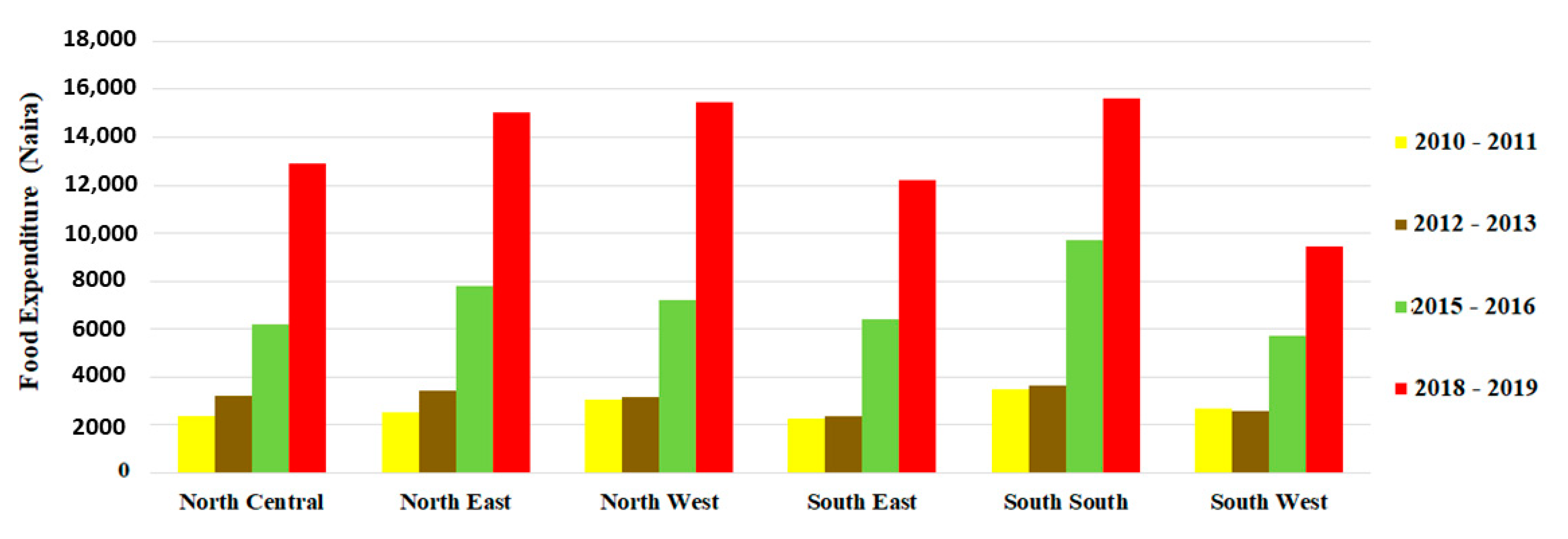
References
- SDG. “2030 Agenda for Sustainable Development”—United Nations Sustainable Development Goals. 2015. Available online: https://www.un.org/sustainabledevelopment/development-agenda/ (accessed on 11 December 2021).
- Schmidt-Traub, G.; Kroll, C.; Teksoz, K.; Durand-Delacre, D.; Sachs, J.D. National baselines for the Sustainable Development Goals assessed in the SDG Index and Dashboards. Nat. Geosci. 2017, 10, 547–555. [Google Scholar] [CrossRef]
- Osendarp, S.; Akuoku, J.K.; Black, R.E.; Headey, D.; Ruel, M.; Scott, N.; Shekar, M.; Walker, N.; Flory, A.; Haddad, L.; et al. The COVID-19 crisis will exacerbate maternal and child undernutrition and child mortality in low- and middle-income countries. Nat. Food 2021, 2, 476–484. [Google Scholar] [CrossRef]
- Hasegawa, T.; Fujimori, S.; Takahashi, K.; Masui, T. Scenarios for the risk of hunger in the twenty-first century using Shared Socioeconomic Pathways. Environ. Res. Lett. 2015, 10, 014010. [Google Scholar] [CrossRef]
- GNR. Global Nutrition Report: Action on Equity to End Malnutrition (Development Initiatives, 2020). 2020. Available online: https://globalnutritionreport.org/reports/2020-global-nutrition-report/ (accessed on 11 December 2021).
- Trollman, H.; Jagtap, S.; Garcia-Garcia, G.; Harastani, R.; Colwill, J.; Trollman, F. COVID-19 demand-induced scarcity effects on nutrition and environment: Investigating mitigation strategies for eggs and wheat flour in the United Kingdom. Sustain. Prod. Consum. 2021, 27, 1255–1272. [Google Scholar] [CrossRef] [PubMed]
- Arumugam, S.; Özkan, B.; Jayaraman, A.; Mockaısamy, P. Impacts of COVID-19 Pandemic on Global Agriculture, Livelihoods and Food Systems. J. Agric. Sci. 2021, 27, 239–246. [Google Scholar]
- Qaim, M. Food consumption patterns in developing countries. In Encyclopedia of Food Security and Sustainability; Elsevier Science & Technology: Waltham, MA, USA, 2019; Volume 2. [Google Scholar]
- Rasul, G. A Framework for Addressing the Twin Challenges of COVID-19 and Climate Change for Sustainable Agriculture and Food Security in South Asia. Front. Sustain. Food Syst. 2021, 5, 679037. [Google Scholar] [CrossRef]
- Islam, T.T.; Newhouse, D.; Yanez-Pagans, M. International comparisons of poverty in South Asia. Asian Dev. Rev. 2021, 38, 142–175. [Google Scholar] [CrossRef]
- Gödecke, T.; Stein, A.J.; Qaim, M. The global burden of chronic and hidden hunger: Trends and determinants. Glob. Food Secur. 2018, 17, 21–29. [Google Scholar] [CrossRef]
- IFPRI. Global Nutrition Report; International Food Policy Research Institute: Washington, DC, USA, 2017. [Google Scholar]
- Africa Union. In Proceedings of the Maputo Declaration on Agriculture and Food Security, Assembly of the African Union, Maputo, Mozambique, 10–12 July 2003.
- Kearney, J. Food consumption trends and drivers. Philos. Trans. R. Soc. Lond. B Biol. Sci. 2010, 365, 2793–2807. [Google Scholar] [CrossRef] [PubMed]
- Owoo, N.S. Demographic considerations and food security in Nigeria. J. Soc. Econ. Dev. 2021, 23, 128–167. [Google Scholar] [CrossRef]
- Jayne, T.S.; Chamberlin, J.; Headey, D.D. Land pressures, the evolution of farming systems, and development strategies in Africa: A synthesis. Food Policy 2014, 48, 1–17. [Google Scholar] [CrossRef] [Green Version]
- Baca, A.S. The Food Consumption Pattern of the Free Market: The Mexican Experience under NAFTA. Agrar. South J. Political Econ. 2019, 8, 258–286. [Google Scholar]
- Muyanga, M.; Jayne, T.; Kodhek, G.; Ariga, J. Staple Food Consumption Patterns in Urban Kenya: Trends and Policy Implications; Tegemeo Institute of Agricultural Policy and Development, Egerton University: Nairobi, Kenya, 2005. [Google Scholar]
- Chauvin, N.D.; Mulangu, F.; Porto, G. Food Production and Consumption Trends in Sub-Saharan Africa: Prospects for the Transformation of the Agricultural Sector; UNDP Regional Bureau for Africa: New York, NY, USA, 2012; Volume 2, p. 74. [Google Scholar]
- Ene-Obong, H.N.; Sanusi, R.A.; Udenta, E.A.; Williams, I.O.; Anigo, K.M.; Chibuzo, E.C.; Aliyu, H.M.; Ekpe, O.O.; Davidson, G.I. Data collection and assessment of commonly consumed foods and recipes in six geo-political zones in Nigeria: Important for the development of a National Food Composition Database and Dietary Assessment. Food Chem. 2013, 140, 539–546. [Google Scholar] [PubMed]
- Savige, G.S.; Crawford, D.; Worsley, A.; Ball, K. Food intake patterns among Australian adolescents. Asia Pac. J. Clin. Nutr. 2007, 16, 738–747. [Google Scholar] [PubMed]
- Rivera, J.Á.; De Cossío, T.G.; Pedraza, L.S.; Aburto, T.C.; Sánchez, T.G.; Martorell, R. Childhood and adolescent overweight and obesity in Latin America: A systematic review. Lancet Diabetes Endocrinol. 2014, 2, 321–332. [Google Scholar] [CrossRef]
- Partearroyo, T.; Samaniego-Vaesken, M.D.L.; Ruiz, E.; Aranceta-Bartrina, J.; Gil, Á.; González-Gross, M.; Ortega, R.M.; Serra-Majem, L.; Varela-Moreiras, G. Current food consumption amongst the spanish anibes study population. Nutrients 2019, 11, 2663. [Google Scholar] [CrossRef] [Green Version]
- Cao, L.J.; Tian, W.-M.; Wang, J.-M.; Malcolm, B.; Liu, H.-B.; Zhou, Z.-Y. Recent Food Consumption Trends in China and Trade. Australas. Agribus. Rev. 2013, 21, 15–44. [Google Scholar]
- Akram, W.; Henneberry, S. Consumption Patterns of Urban Punjab of Pakistan: Evidence from HIES 2013–2014. In Proceedings of the Agricultural & Applied Economics Association Annual Meeting, Boston, MA, USA, 31 July–2 August 2016. [Google Scholar]
- Galbete, C.; Nicolaou, M.; Meeks, K.A.; De Graft-Aikins, A.; Addo, J.; Amoah, S.K.; Smeeth, L.; Owusu-Dabo, E.; Klipstein-Grobusch, K.; Bahendeka, S.; et al. Food consumption, nutrient intake, and dietary patterns in Ghanaian migrants in Europe and their compatriots in Ghana. Food Nutr. Res. 2017, 61, 1341809. [Google Scholar] [CrossRef] [Green Version]
- Streeter, J.L. Socioeconomic factors affecting food consumption and nutrition in China: Empirical evidence during the 1989–2009 period. Chin. Econ. 2017, 50, 168–192. [Google Scholar] [CrossRef]
- Song, F.; Cho, M.S. Geography of food consumption patterns between South and North China. Foods 2017, 6, 34. [Google Scholar] [CrossRef] [Green Version]
- Mottaleb, K.A.; Rahut, D.B.; Kruseman, G.; Erenstein, O. Changing food consumption of households in developing countries: A Bangladesh case. J. Int. Food Agribus. Mark. 2018, 30, 156–174. [Google Scholar] [CrossRef]
- Sharma, R.; Nguyen, T.T.; Grote, U. Changing consumption patterns—Drivers and the environmental impact. Sustainability 2018, 10, 4190. [Google Scholar] [CrossRef] [Green Version]
- Saleem, S.B.; Ali, Y. Effect of lifestyle changes and consumption patterns on environmental impact: A comparison study of Pakistan and China. Chin. J. Popul. Resour. Environ. 2019, 17, 113–122. [Google Scholar] [CrossRef]
- Razack, N.; Ludin, A. Ecological footprint and food consumption in Minna, Nigeria. In IOP Conference Series: Earth and Environmental Science; IOP Publishing: Bristol, UK, 2014. [Google Scholar]
- Akerele, D. Household food expenditure patterns, food nutrient consumption and nutritional vulnerability in Nigeria: Implications for policy. J. Ecol. Food Nutr. 2015, 54, 546–571. [Google Scholar] [CrossRef]
- Ranganathan, J.; Vennard, D.; Waite, R.; Searchinger, T.; Dumas, P.; Lipinski, B. Shifting diets: Toward a sustainable food future. In Global Food Policy Report; International Food Policy Research Institute (IFPRI): Washington, DC, USA, 2016. [Google Scholar]
- Ray, S.; Bhattacharyya, B. A statistical investigation on analysis of food consumption pattern in India. J. Crop Weed 2016, 12, 47–54. [Google Scholar]
- Zhen, L.; Du, B. Ecological Footprint Analysis Based on Changing Food Consumption in a Poorly Developed Area of China. Sustainability 2017, 9, 1323. [Google Scholar] [CrossRef] [Green Version]
- Ecker, O. Agricultural transformation and food and nutrition security in Ghana: Does farm production diversity (still) matter for household dietary diversity? Food Policy 2018, 79, 271–282. [Google Scholar] [CrossRef]
- Yin, J.; Yang, D.; Zhang, X.; Zhang, Y.; Cai, T.; Hao, Y.; Cui, S.; Chen, Y. Diet shift: Considering environment, health and food culture. Sci. Total Environ. 2020, 719, 137484. [Google Scholar] [CrossRef] [PubMed]
- Gerbens-Leenes, W.; Nonhebel, S. Food and land use. The influence of consumption patterns on the use of agricultural resources. Appetite 2005, 45, 24–31. [Google Scholar] [CrossRef] [Green Version]
- Alexander, P.; Brown, C.; Arneth, A.; Finnigan, J.; Rounsevell, M.D.A. Human appropriation of land for food: The role of diet. Glob. Environ. Chang. 2016, 41, 88–98. [Google Scholar] [CrossRef] [Green Version]
- Gerbens-Leenes, P.W.; Nonhebel, S.; Ivens, W.P.M.F. A method to determine land requirements relating to food consumption patterns. Agric. Ecosyst. Environ. 2002, 90, 47–58. [Google Scholar] [CrossRef]
- Wirsenius, S.; Azar, C.; Berndes, G. How much land is needed for global food production under scenarios of dietary changes and livestock productivity increases in 2030? Agric. Syst. 2010, 103, 621–638. [Google Scholar] [CrossRef]
- Kastner, T.; Rivas, M.J.I.; Koch, W.; Nonhebel, S. Global changes in diets and the consequences for land requirements for food. Proc. Natl. Acad. Sci. USA 2012, 109, 6868–6872. [Google Scholar] [CrossRef] [PubMed] [Green Version]
- Zhen, L.; Cao, S.; Cheng, S.; Xie, G.; Wei, Y.; Liu, X.; Li, F. Arable land requirements based on food consumption patterns: Case study in rural Guyuan District, Western China. Ecol. Econ. 2010, 69, 1443–1453. [Google Scholar] [CrossRef]
- Das, K.; Nonhebel, S. A comparative study of the land required for food and cooking fuel in rural India. Agric. Syst. 2019, 176, 102682. [Google Scholar] [CrossRef]
- Kastner, T.; Nonhebel, S. Changes in land requirements for food in the Philippines: A historical analysis. Land Use Policy 2010, 27, 853–863. [Google Scholar] [CrossRef]
- Hoff, M.; De Boer, H.J. A Question-Based Method to Calculate the Human Appropriation of Land for Food (HALF) Index. Sustainability 2020, 12, 10597. [Google Scholar] [CrossRef]
- UNICEF. Nutrition Report on Nigeria; United Nations International Children’s Emergency Fund: New York, NY, USA, 2019. [Google Scholar]
- WorldPoverty. World Poverty Clock; World Data: Vienna, Austria, 2020. [Google Scholar]
- Mekonnen, D.A.; Trijsburg, L.; Achterbosch, T.; Brouwer, I.D.; Kennedy, G.; Linderhof, V.; Ruben, R.; Talsma, E.F. Food consumption patterns, nutrient adequacy, and the food systems in Nigeria. Agric. Food Econ. 2021, 9, 16. [Google Scholar] [CrossRef]
- Ajakaiye, O.; Jerome, A.T.; Olaniyan, O.; Mahrt, K.; Alaba, O.A. Spatial and temporal multidimensional poverty in Nigeria. In Growth and Poverty in sub-Saharan Africa; Katajanokanlaituri 6 B: Helsinki, Finland, 2016; Volume 218. [Google Scholar]
- FAO. Nigeria Agriculture at a Glance; Garki: Abuja, Nigeria, 2021. [Google Scholar]
- Chapin Metz, H. Nigeria: A Country Study; GPO for the Library of Congress: Washington, DC, USA, 1991. [Google Scholar]
- Ikuemonisan, E.; Mafimisebi, T.E.; Ajibefun, I.; Adenegan, K. Cassava production in Nigeria: Trends, instability and decomposition analysis (1970–2018). Heliyon 2020, 6, e05089. [Google Scholar] [CrossRef]
- Ismaila, U.; Gana, A.S.; Tswanya, N.M.; Dogara, D. Cereals production in Nigeria: Problems, constraints and opportunities for betterment. Afr. J. Agric. Res. 2010, 5, 1341–1350. [Google Scholar]
- United Nations Industrial Development Organization. Independent Country Evaluation; Federal Republic of Nigeria; FINAL REPORT; United Nations Industrial Development Organization: Vienna, Austria, 2008; Volume 2. [Google Scholar]
- The Federal Republic of Nigeria Poverty Work Program. Poverty Reduction in Nigeria in the Last Decade. In Poverty Global Practice, Africa Region; World Bank: Washington, DC, USA, 2016. [Google Scholar]
- FAOSTAT. Food and Agricultural Organization of the United Nations Statistics; FAOSTAT: Abuja, Nigeria, 2000. [Google Scholar]
- NBS. General Household Survey in Nigeria (Living Standard Measurement Survey Wave 4); National Bureau of Statistics (NBS): Abuja, Nigeria, 2019. [Google Scholar]
- NBS. Nigeria Bureau of Statistics—Consumption Expenditure Pattern in Nigeria; National Bureau of Statistics Central Business District, FCT: Abuja, Nigeria, 2019. [Google Scholar]
- NBS. Nigeria Bureau of Statistics—Selected Food Prices; NBS: Abuja, Nigeria, 2019. [Google Scholar]
- FMARD. Federal Ministry of Agriculture and Rural Development, Nigeria; FMARD: Abuja, Nigeria, 2017. [Google Scholar]
- NAERLS. National Agricultural Extension and Research Liaison Services, Nigeria; NAERLS: Zaria, Nigeria, 2017. [Google Scholar]
- NGCC. National Geomatics Center of China—GLOBELAND30 PROJECT; NGCC: Beijing, China, 2020. [Google Scholar]
- INDDEX. International Dietary Data Expansion Project. In Data4Diets: Building Blocks for Diet-related Food Security Analysis; Tufts University: Boston, MA, USA, 2018. [Google Scholar]
- NBS, Nigeria Bureau of Statistics. 2019 Poverty and Inequality in Nigeria Report; NBS, Nigeria Bureau of Statistics: Lagos, Nigeria, 2019. [Google Scholar]
- Smith, L.C.; Subandoro, A. Measuring Food Security Using Household Expenditure Surveys; International Food Policy Research Institute (IFPRI): Washington, DC, USA, 2007; Volume 3. [Google Scholar]
- Osabuohien, E.S.; Okorie, U.E.; Osabohien., R.A. Rice Production and Processing in Ogun State, Nigeria: Qualitative Insights from Farmers’ Association; IGI Global: Hershey, PA, USA, 2018. [Google Scholar]
- Agada, M.; Igbokwe, E. Influence of Food Culture and Practices on Household Food Security in North Central Nigeria. J. Food Secur. 2016, 4, 36–41. [Google Scholar]
- Iorlamen, T.R.; Abu, G.A.; Lawal, W.L. Assessment of expenditure on food among urban households and it’s implication for food security: Evidence from Benue State, Nigeria. Afr. J. Food Agric. Nutr. Dev. 2014, 14, 8748–8760. [Google Scholar]
- Olayemi, A.O. Effects of family size on household food security in Osun State, Nigeria. J. Asian J. Agric. Rural. Dev. 2012, 2, 136–141. [Google Scholar]
- Qian, L.; Li, F.; Liu, H.; Wang, L.; McCarthy, B.; Jin, S. Rice vs. Wheat: Does staple food consumption pattern affect food waste in Chinese university canteens? Resour. Conserv. Recycl. 2022, 176, 105902. [Google Scholar] [CrossRef]

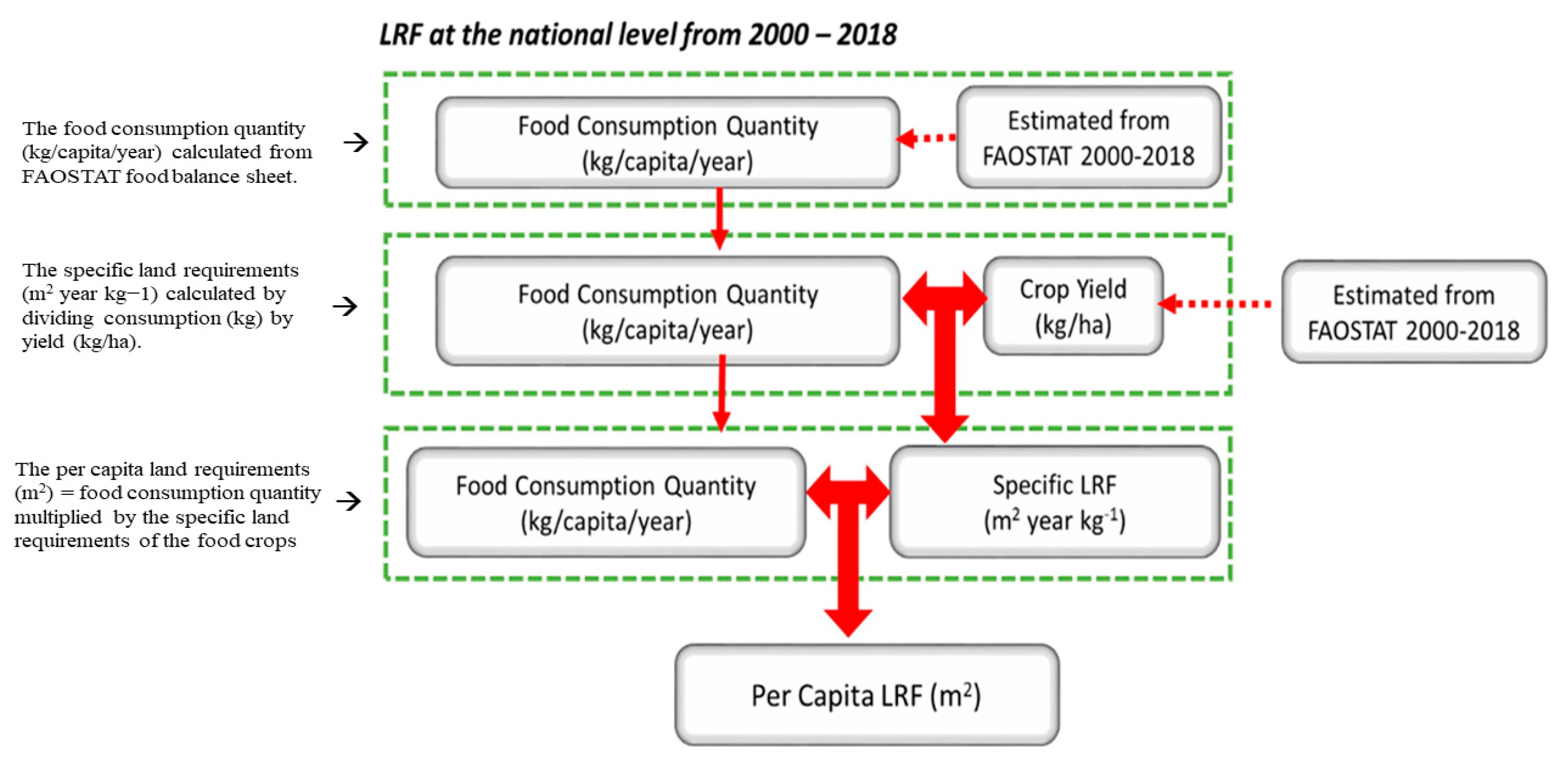

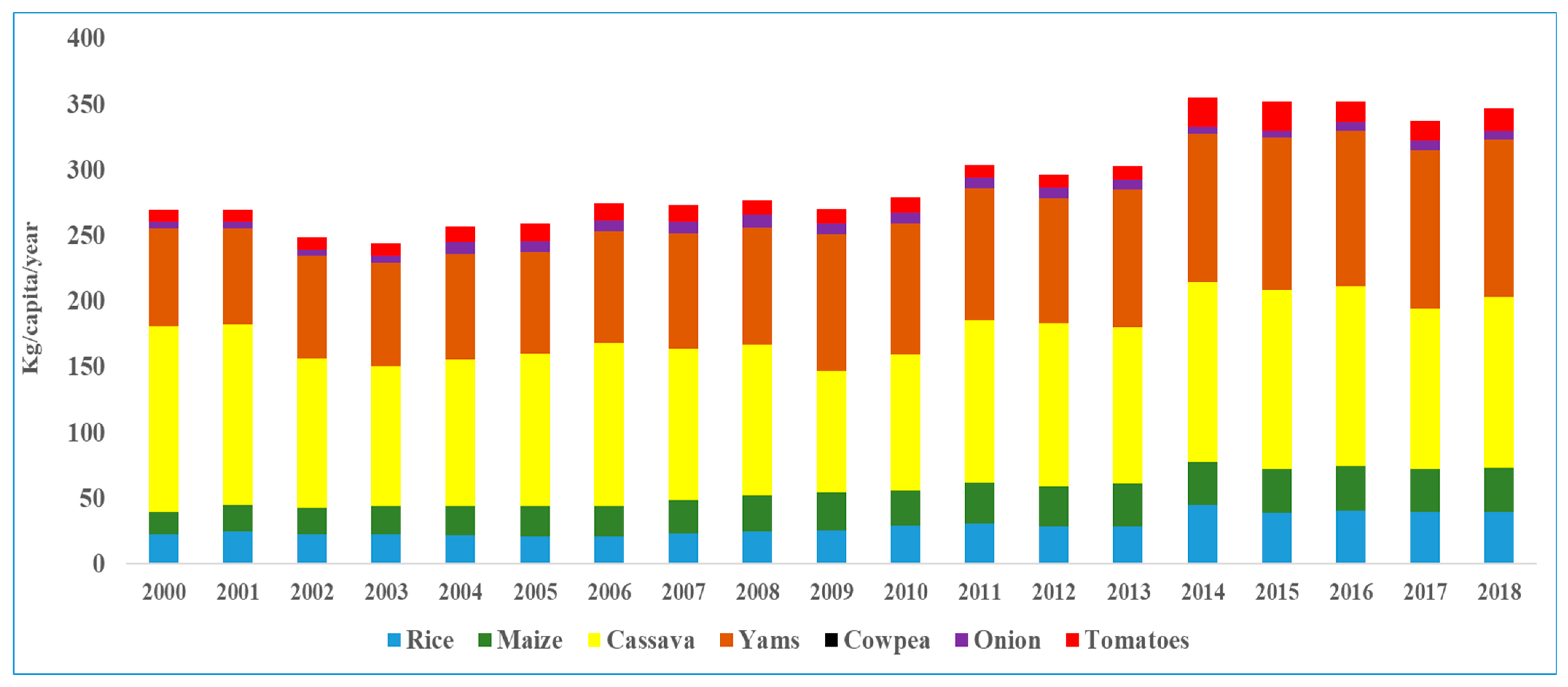
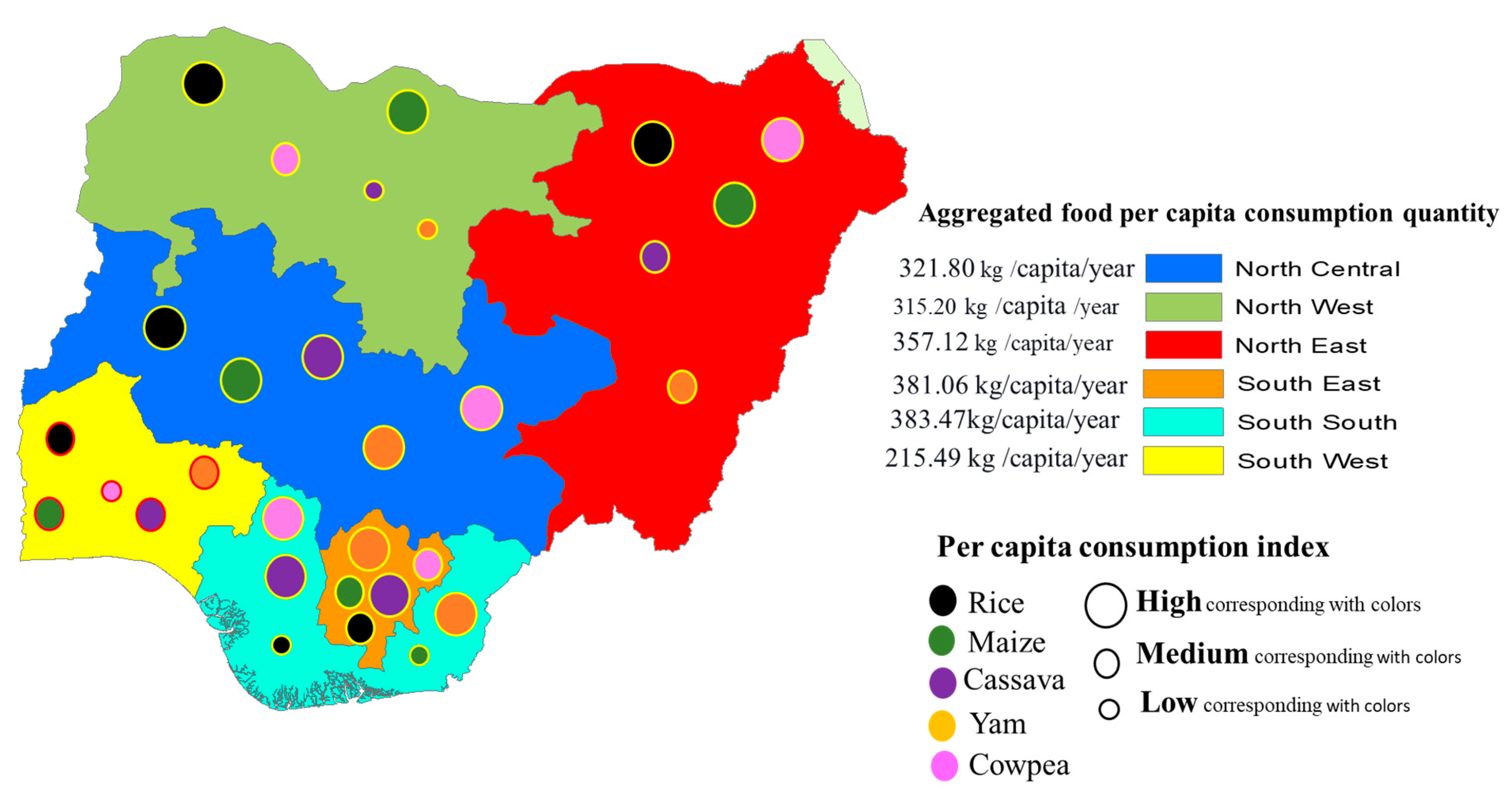
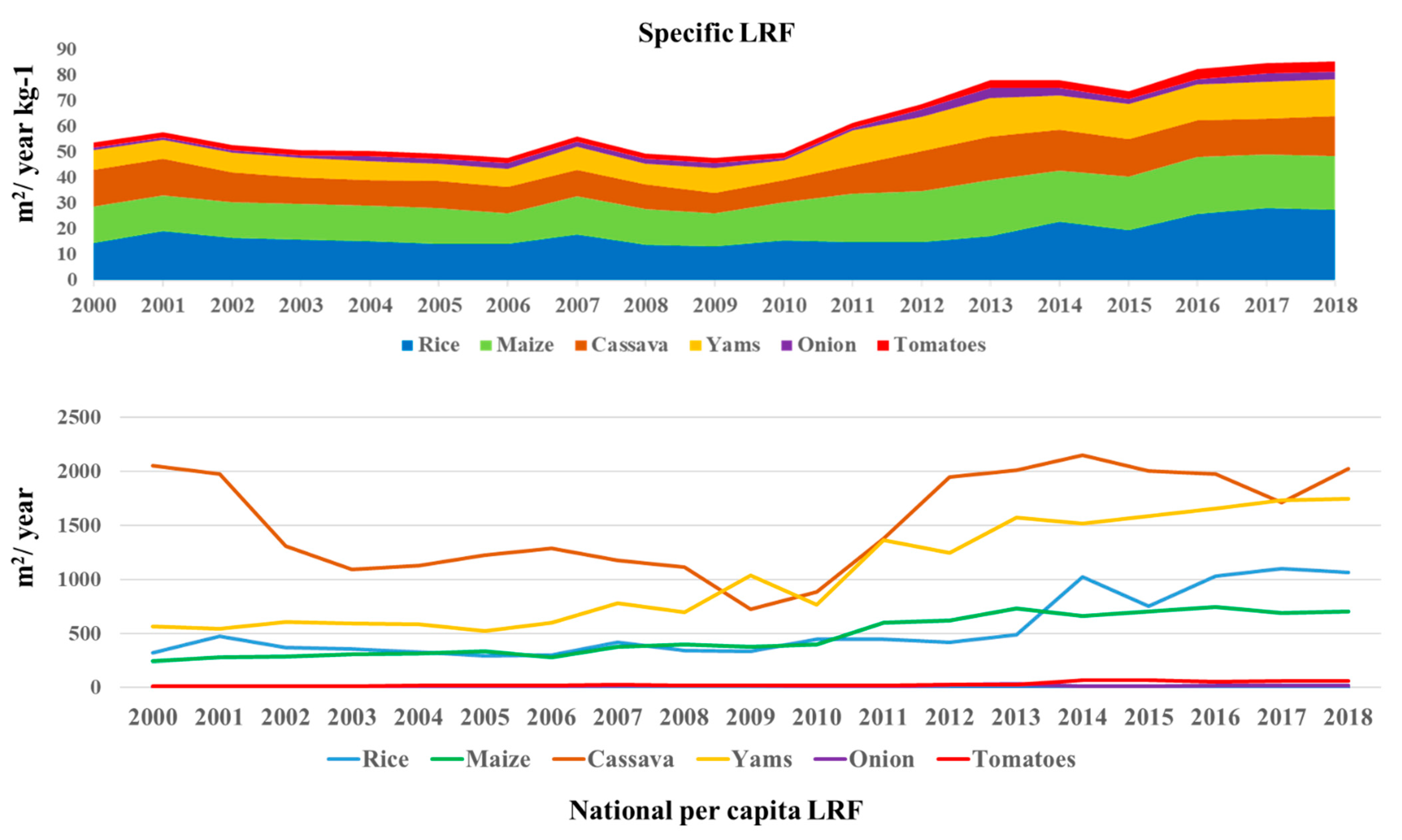
| Zones | Average Household Size (2018–2019) | Total Land Area (ha) (2020) | Cropland Area (ha) (2020) | Crops Commonly Cultivated and Farming System | Population (2016) | Ethnic Groups |
|---|---|---|---|---|---|---|
| North Central | 5.7 | 24,242,500 | 12,230,953 | Cassava, yams, sorghum, millet, maize, rice, cowpea, and commercial livestock farming. | 29,252,408 | Tiv, Igala, Berom, and others. |
| North East | 7.9 | 27,239,500 | 11,880,402 | Maize, millet, sorghum, wheat, rice, cowpea, and commercial livestock farming | 26,263,866 | Hausa |
| North West | 7.4 | 21,606,500 | 13,271,431 | Rice, millet, sorghum, maize, cowpea, and vegetables, and commercial livestock farming. | 48,942,307 | Hausa |
| South East | 4.3 | 2,952,500 | 1,406,476 | Cassava, yams, maize rice, and subsistence livestock farming | 21,955,414 | Igbo |
| South South | 4.9 | 8,458,700 | 2,507,664 | Cassava, yam, vegetables, plantain, and subsistence livestock farming | 28,829,288 | Ibibio, Bini, Ijaw, and others. |
| South West | 3.2 | 7,966,500 | 2,442,536 | Rice, maize, casava, yam, plantain, and subsistence livestock farming. | 38,257,260 | Yoruba |
| National | 5.5 | 92,466,200 | 43,739,462 | Mixed farming | 193,500,543 | Major: Igbo, Hausa and Yoruba |
| Data Source | Data | Year |
|---|---|---|
| Food and Agricultural Organization (FAOSTAT) | Food Balance Sheet and Production | 2000–2018, 2017 |
| Nigeria Bureau of Statistics | General Household Survey in Nigeria (LSMS Wave 4) | 2018–2019 |
| Nigeria Bureau of Statistics | Consumption Expenditure Pattern in Nigeria | 2019 |
| Nigeria Bureau of Statistics | Selected Food Prices | 2018 |
| Federal Ministry of Agriculture and Rural Development (FMARD) and the National Agricultural Extension and Research Liaison Services (NAERLS) | Food Crop Production and Harvested Area Statistics | 2017 |
| National Geomatics Center of China | 30 m land use land cover images | 2020 |
| Zones | Average Household Size | Combined Population (2016) | RICE (kg) | MAIZE (kg) | CASSAVA (kg) | YAM (kg) | COWPEA (kg) | ONION (kg) | TOMATO (kg) |
|---|---|---|---|---|---|---|---|---|---|
| North Central | 5.7 | 513.30 | 339.37 | 507.10 | 388.93 | 85.59 | 160.66 | 146.79 | |
| North East | 7.9 | 104,458,581 | 885.59 | 1469.69 | 141.22 | 179.66 | 145.06 | 225.81 | 186.61 |
| North West | 7.4 | 1019.82 | 1032.20 | 103.52 | 92.86 | 84.04 | 210.00 | 168.43 | |
| South East | 4.3 | 175.61 | 36.48 | 686.55 | 683.66 | 56.28 | 222.25 | 186.56 | |
| South South | 4.9 | 89,041,962 | 153.12 | 21.71 | 978.13 | 647.00 | 79.03 | 133.68 | 93.10 |
| South West | 3.2 | 181.49 | 100.07 | 209.44 | 159.52 | 39.07 | 113.48 | 99.62 |
| Zones | Food Item | Specific Land Requirement (ha/Year kg−1) | Per Capita Food Consumption (kg/Capita/Year) | Total Household Food Consumption (kg Year−1) | Per Capita Land Requirement (ha/Year) | Household Land Requirement (ha/Year) | Household Sizes |
|---|---|---|---|---|---|---|---|
| North Central | Rice | 0.034 | 90.05 | 513.30 | 3.06 | 17.44 | |
| Maize | 0.019 | 59.54 | 339.37 | 1.13 | 6.44 | ||
| Cassava | 0.009 | 88.96 | 507.10 | 0.80 | 4.56 | ||
| Yam | 0.003 | 68.23 | 388.93 | 0.20 | 1.14 | 5.7 | |
| Cowpea | 0.011 | 15.02 | 85.59 | 0.17 | 0.97 | ||
| Onion | 0.032 | 28.19 | 160.66 | 0.90 | 5.13 | ||
| Tomato | 0.004 | 25.75 | 146.79 | 0.10 | 0.57 | ||
| Sub-total | 0.112 | 375.74 | 2141.74 | 6.37 | 36.25 | ||
| North East | Rice | 0.073 | 112.10 | 885.59 | 8.18 | 64.62 | |
| Maize | 0.104 | 186.04 | 1469.69 | 19.35 | 152.87 | ||
| Cassava | 0.003 | 17.88 | 141.22 | 0.05 | 0.40 | ||
| Yam | 0.005 | 22.74 | 179.66 | 0.11 | 0.87 | 7.9 | |
| Cowpea | 0.016 | 18.36 | 145.06 | 0.29 | 2.29 | ||
| Onion | 0.008 | 28.58 | 225.81 | 0.23 | 1.82 | ||
| Tomato | 0.004 | 23.62 | 186.61 | 0.09 | 0.71 | ||
| Sub-total | 0.213 | 409.32 | 3233.64 | 28.32 | 223.57 | ||
| North West | Rice | 0.074 | 137.81 | 1019.82 | 10.20 | 75.48 | |
| Maize | 0.069 | 139.49 | 1032.20 | 9.62 | 71.19 | ||
| Cassava | 0.002 | 13.99 | 103.52 | 0.03 | 0.22 | ||
| Yam | 0.003 | 12.55 | 92.86 | 0.04 | 0.30 | 7.4 | |
| Cowpea | 0.010 | 11.36 | 84.04 | 0.11 | 0.81 | ||
| Onion | 0.007 | 28.38 | 210.00 | 0.20 | 1.48 | ||
| Tomato | 0.004 | 22.76 | 168.43 | 0.09 | 0.67 | ||
| Sub-total | 0.169 | 366.34 | 2710.87 | 20.29 | 150.15 | ||
| South East | Rice | 0.013 | 40.84 | 175.61 | 0.53 | 2.28 | |
| Maize | 0.003 | 8.48 | 36.48 | 0.03 | 0.13 | ||
| Cassava | 0.009 | 159.66 | 686.55 | 1.44 | 6.19 | ||
| Yam | 0.008 | 158.99 | 683.66 | 1.27 | 5.46 | 4.3 | |
| Cowpea | 0.007 | 13.09 | 56.28 | 0.09 | 0.39 | ||
| Onion | 0.179 | 51.69 | 222.25 | 9.25 | 39.78 | ||
| Tomato | 0.007 | 43.39 | 186.56 | 0.30 | 1.29 | ||
| Sub-total | 0.226 | 476.14 | 2047.39 | 12.91 | 55.51 | ||
| South South | Rice | 0.012 | 31.25 | 153.12 | 0.38 | 1.86 | |
| Maize | 0.002 | 4.43 | 21.71 | 0.01 | 0.05 | ||
| Cassava | 0.018 | 199.62 | 978.13 | 3.59 | 17.59 | ||
| Yam | 0.011 | 132.04 | 647.00 | 1.45 | 7.11 | 4.9 | |
| Cowpea | 0.011 | 16.13 | 79.03 | 0.18 | 0.88 | ||
| Onion | 0.108 | 27.28 | 133.68 | 2.95 | 14.46 | ||
| Tomato | 0.005 | 19.00 | 93.10 | 0.09 | 0.44 | ||
| Sub-total | 0.167 | 429.75 | 2105.77 | 8.65 | 42.39 | ||
| South West | Rice | 0.014 | 56.71 | 181.49 | 0.79 | 2.53 | |
| Maize | 0.007 | 31.27 | 100.07 | 0.22 | 0.70 | ||
| Cassava | 0.003 | 65.45 | 209.44 | 0.13 | 0.42 | ||
| Yam | 0.002 | 49.85 | 159.52 | 0.10 | 0.32 | 3.2 | |
| Cowpea | 0.006 | 12.21 | 39.07 | 0.07 | 0.22 | ||
| Onion | 0.025 | 35.46 | 113.48 | 0.89 | 2.85 | ||
| Tomato | 0.002 | 31.13 | 99.62 | 0.06 | 0.19 | ||
| Sub-total | 0.059 | 429.75 | 902.69 | 8.65 | 42.39 | ||
| TOTAL | 0.946 | 2487.04 | 13,142.1 | 85.19 | 515.1 |
| Zones | Combined Household Land Requirements of the 7 Food Crops (Ha) | Projected Household Land Requirements of the 7 Food Crops (Ha) |
|---|---|---|
| North Central | 36.25 | 2016 estimated population = 193 million ↓ National average household size of 5 ↓ Which gives 38.6 million households in Nigeria. ↓ 38.6 million households × our study household LR of 515.1 ha |
| North East | 223.57 | |
| North West | 150.15 | |
| South East | 55.51 | |
| South South | 42.39 | |
| South West | 7.23 | |
| TOTAL | 515.1 | |
| National GHS of 5000 households | 2,575,500 | Gap = 19,882,860,000 |
Publisher’s Note: MDPI stays neutral with regard to jurisdictional claims in published maps and institutional affiliations. |
© 2022 by the authors. Licensee MDPI, Basel, Switzerland. This article is an open access article distributed under the terms and conditions of the Creative Commons Attribution (CC BY) license (https://creativecommons.org/licenses/by/4.0/).
Share and Cite
Chiaka, J.C.; Zhen, L.; Xiao, Y. Changing Food Consumption Patterns and Land Requirements for Food in the Six Geopolitical Zones in Nigeria. Foods 2022, 11, 150. https://doi.org/10.3390/foods11020150
Chiaka JC, Zhen L, Xiao Y. Changing Food Consumption Patterns and Land Requirements for Food in the Six Geopolitical Zones in Nigeria. Foods. 2022; 11(2):150. https://doi.org/10.3390/foods11020150
Chicago/Turabian StyleChiaka, Jeffrey Chiwuikem, Lin Zhen, and Yu Xiao. 2022. "Changing Food Consumption Patterns and Land Requirements for Food in the Six Geopolitical Zones in Nigeria" Foods 11, no. 2: 150. https://doi.org/10.3390/foods11020150
APA StyleChiaka, J. C., Zhen, L., & Xiao, Y. (2022). Changing Food Consumption Patterns and Land Requirements for Food in the Six Geopolitical Zones in Nigeria. Foods, 11(2), 150. https://doi.org/10.3390/foods11020150







